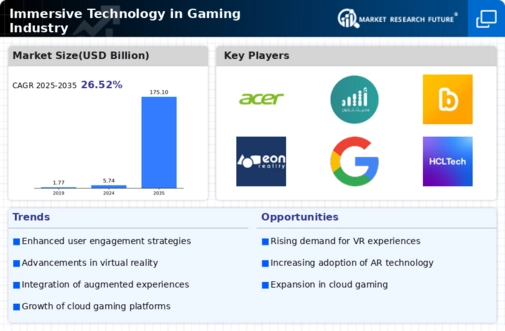Market Share
Immersive Technology in Gaming Industry Market Share Analysis
Market share positioning strategies are vital in the Immersive Technology in Gaming Market, an industry characterized by rapid technological advancements and increasing demand for immersive gaming experiences. Companies operating in this space employ various tactics to establish their share of the market and differentiate themselves from competitors. One prevalent strategy is differentiation, where companies focus on offering unique immersive gaming technologies and experiences that set them apart. This could involve the development of proprietary virtual reality (VR) or augmented reality (AR) hardware and software, advanced motion tracking systems, or immersive storytelling techniques. By emphasizing these distinctive features, companies can attract gamers seeking immersive experiences that go beyond traditional gaming platforms.
Cost leadership is another key strategy utilized by companies in the Immersive Technology in Gaming Market. By providing cost-effective immersive gaming solutions without compromising on quality, companies can appeal to budget-conscious gamers and gain market share by targeting price-sensitive segments. This approach involves optimizing manufacturing processes, sourcing components efficiently, and offering competitive pricing to make immersive gaming more accessible to a broader audience. Additionally, companies may focus on expanding their market reach through strategic marketing and distribution efforts. This could involve partnerships with gaming hardware manufacturers, content developers, or retail channels to extend their market presence and reach new customers.
Furthermore, niche-focused strategies are common in the Immersive Technology in Gaming Market, with companies specializing in serving specific gaming genres or target demographics. By focusing on niche markets such as multiplayer VR experiences, location-based entertainment, or educational gaming applications, companies can develop deep domain expertise and tailor their immersive gaming solutions to meet the unique preferences and needs of those segments. This targeted approach allows companies to differentiate themselves from broader competitors and position themselves as leaders within their chosen niche. Additionally, investing in research and development to innovate and stay ahead of emerging trends and technologies is critical for long-term success. This might involve developing new gaming mechanics, content creation tools, or interactive storytelling techniques to push the boundaries of immersive gaming experiences.
Partnerships and alliances also play a significant role in expanding market share in the Immersive Technology in Gaming Market. By collaborating with game developers, content creators, or entertainment studios, companies can leverage each other's strengths and resources to deliver compelling immersive gaming experiences. Strategic partnerships can help companies gain access to exclusive content, expand their gaming library, and enhance the overall value proposition for gamers. Additionally, companies may prioritize enhancing user experience and satisfaction to build brand loyalty and drive repeat business. This could involve providing responsive customer support, regular software updates, or value-added services such as online communities or multiplayer gaming platforms to foster engagement and community building among gamers.













Leave a Comment